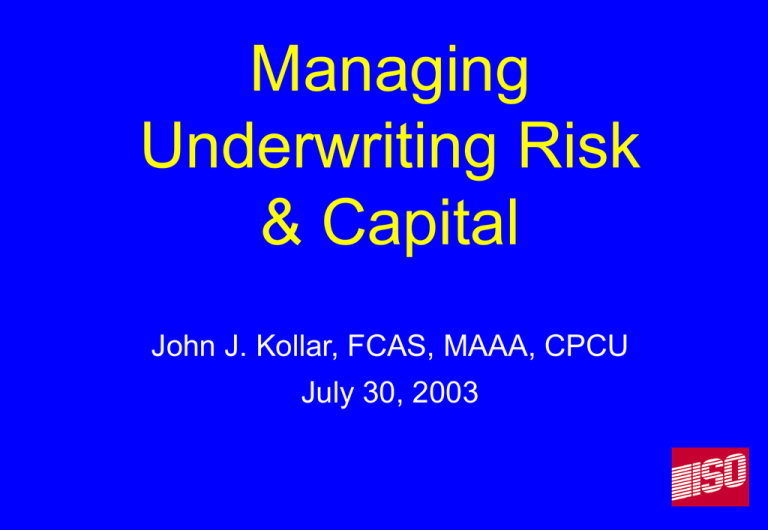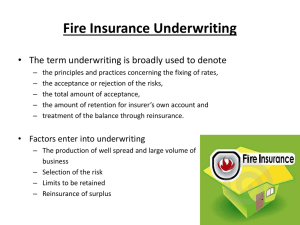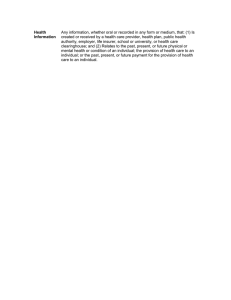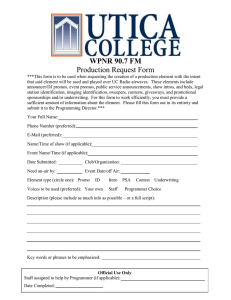Managing Underwriting Risk & Capital John J. Kollar, FCAS, MAAA, CPCU
advertisement

Managing Underwriting Risk & Capital John J. Kollar, FCAS, MAAA, CPCU July 30, 2003 Enterprise Risk Management Enterprise Risk Investment Risk Underwriting Risk Catastrophe Risk Underwriting Risk • Loss volatility (including catastrophic risk) • Correlation between lines (dependencies) • Risk of adverse development for long-tailed lines • Underwriting cycles=varying margins – Varying real prices – Varying underwriting selectivity Constructing an Underwriting Risk Model (URM) Fit claim severity distributions by line. • Use individual claim severity – Aggregate data of many insurers – By line – By settlement lag • to estimate industry parameters for claim severity distributions – By line – By settlement lag Constructing URM (Cont’d) Fit claim frequency distributions by line. • Use net expected losses, exposures – By insurer – By line – By settlement lag To estimate • Industry parameters for the claim frequency distributions – By line – By settlement lag • Correlations between lines URM Input • Insurer expected losses – By line – By settlement lag • Policy Limits • Reinsurance • Use industry estimates for other parameters. • Include insurer’s catastrophe loss distributions (catastrophe modeler). • Can adjust losses by an economic scenario generator. Calculating an Insurer’s Underwriting Risk Via URM • Use the collective risk model. – Separate claim frequency and severity analysis. • For each line of insurance: – Select a random claim count. Use industry claim frequency parameters. – Select random claim size for each claim. Use industry claim severity parameters. Adjust for policy limits and reinsurance. Calculating an Insurer’s Underwriting Risk Via URM (Cont’d) • The aggregate loss for all lines = sum of all the random claim amounts for all lines. – Reflect the correlation between lines of insurance. • Repeat the above thousands of times (simulation) or use Fourier transforms to calculate the insurer’s aggregate loss distribution. – Total – By profit center Calculating an Insurer’s Underwriting Risk Via URM (Cont’d) • What is the tolerance for risk? – Regulatory requirement (RBC) – “A” rating from a rating agency – Tradition, etc. • Select a statistical measure of risk that corresponds to the tolerance for risk. – Value at risk – Tail value at risk – Standard deviation, etc. • Determine total capital for underwriting from the aggregate loss distribution using the selected measure of risk. Allocating (Cost of) Capital • Calculate marginal capital for each profit center. • Calculate the sum of the marginal capital for all capital centers. • Diversification multiplier equals the total capital divided by the sum of the marginal capital. • Allocated capital for each profit center equals the product of the diversification multiplier and the marginal capital for the profit center. Minimizing the Cost of Financing • Cost of capital = return x capital – Discounted – Post tax – By profit center • Cost of reinsurance = frictional cost – For each program • Cost of financing = cost of reinsurance + cost of capital – For each program/profit center • Minimize the total cost of financing Setting Combined Ratio Targets by Line • • • • Expected losses Expected expenses Investment income Cost of financing Planning Underwriting Strategy • Add policies/portfolios that increase the return on capital. • Drop policies that cause a drop in return on capital.





